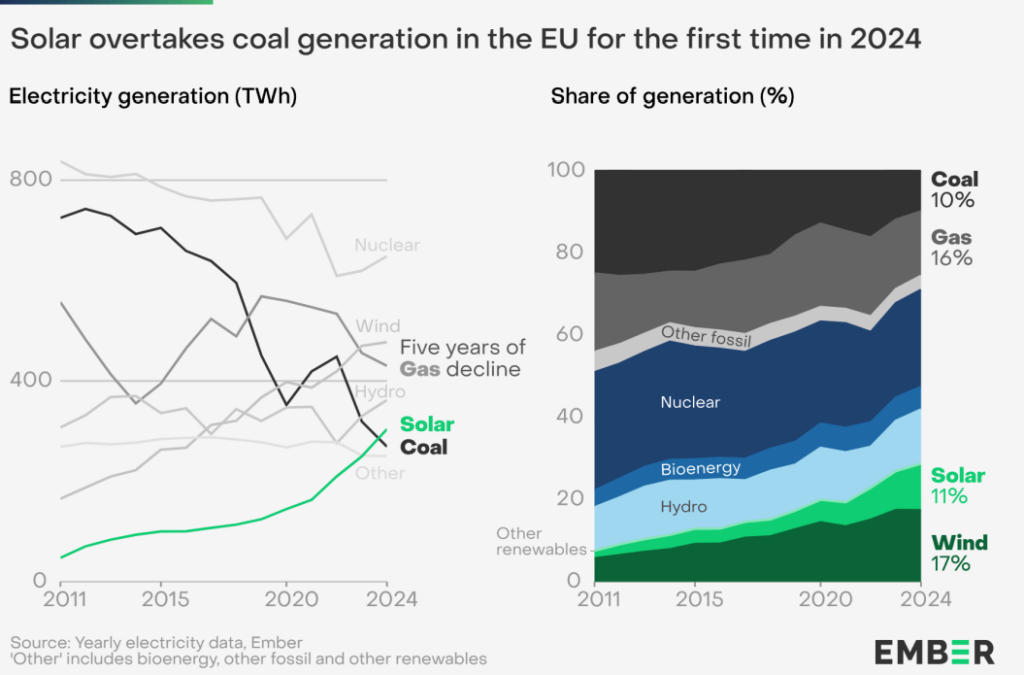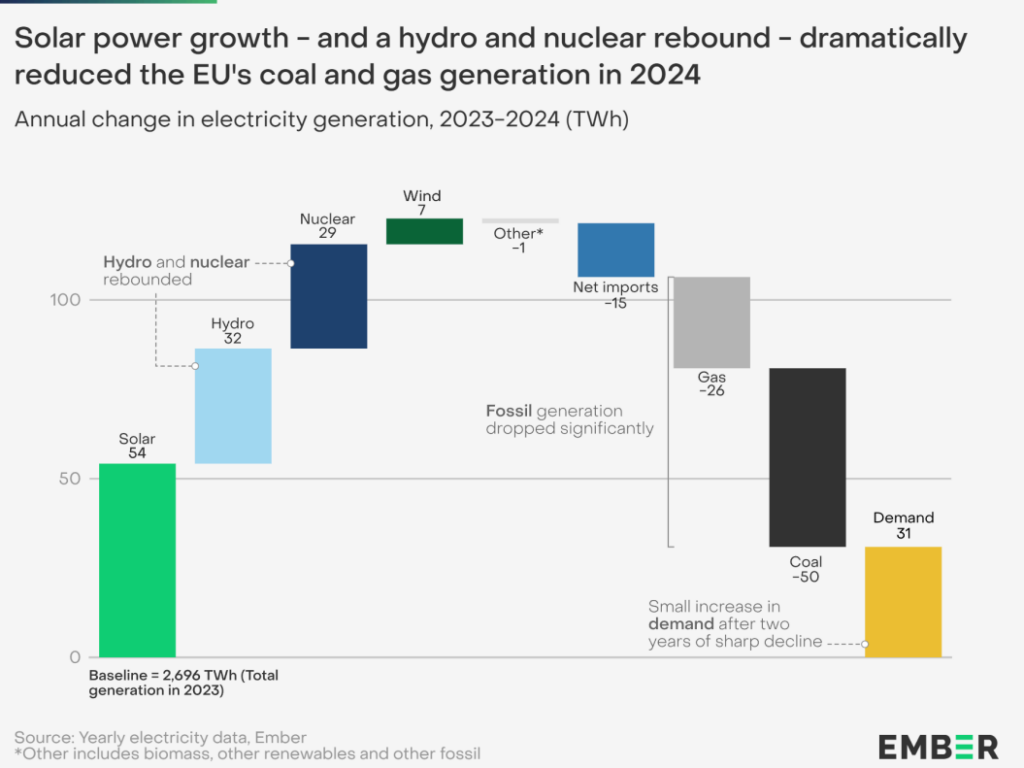In a report released today. message on last year's power generation developments in 27 European countries, the Ember Research Institute said the EU's electricity sector transition maintained its momentum in 2024, despite challenging political and economic conditions. Solar power grew strongly, overtaking coal power for the first time. Another year of decline in coal and gas-fired power - the fifth year in a row for gas - reduced EU power sector emissions to below half their 2007 peak and further reduced dependence on fossil fuel imports. Significant progress has been made during the last EU policy cycle but needs to be accelerated.
The Green Deal has brought about a profound and rapid transformation of the EU's energy sector. Thanks to expanding wind and solar power, the share of renewables has risen from 34 % in 2019 to 47 % in 2024, while the share of fossil fuels has fallen from 39 % to a historic low of 29 %. Solar energy remained the fastest growing energy source in the EU in 2024, surpassing coal for the first time. Wind power remained the second largest energy source in the EU, above gas and below nuclear.
Significant progress has brought benefits beyond emissions reductions. The structural growth of wind and solar power has reduced the EU's fossil fuel import bill and the bloc's vulnerability to gas imports. While the progress made in the first half of this decade is impressive, it needs to be accelerated by 2030.
Solar power has overtaken coal
Solar was the fastest growing energy source in the EU in 2024; capacity additions reached a record high and generation was 22 % higher than in 2023. Solar (11 %, 304 TWh) overtook coal (10 %, 269 TWh) for the first time in 2024, meaning that coal fell from its position as the third largest energy source in the EU in 2019 to the sixth position in 2024. This trend is general; solar is growing in every EU country, while coal is becoming increasingly marginal. More than half of EU countries either have no coal power or its share in the energy mix is less than 5 %. Accelerated clean flexibility and smart electrification are needed to sustain solar growth.
Gas declined for five years in a row
Gas-fired electricity generation has fallen for the fifth year in a row - despite a slight recovery in electricity demand. Combined with a further decline in coal, this has led to total power sector emissions in 2024 falling below half their 2007 peak. This sustained decline has played a key role in reducing total EU gas consumption by 20 % over the last five years: around a third of this decline has taken place in the power sector. Without the addition of wind and solar power in 2024, EU gas consumption for the power sector would be 11 % higher.
Wind and solar power have prevented €59 billion worth of fossil fuel imports since the Green Deal began
In the five years that the European Green Deal has been in force, the increase in wind and solar generation is the main reason for the decline in fossil fuel electricity generation. Without the wind and solar capacity added from 2019, the EU would import 92 billion cubic metres more fossil gas and 55 million tonnes more coal, at a cost of €59 billion. To maximise future benefits, Member States need to continue to implement reforms to accelerate the deployment of wind power, as there is currently a risk of inadequate supply despite cost competitiveness.

The amount of progress made in the five years of the Green Deal should inspire confidence in what can be achieved by 2030. Faster deployment of clean flexibility, grid infrastructure and electrification will be key to sustaining clean energy growth. Solar energy remains the fastest growing energy source in the EU, but more storage and demand flexibility are needed to sustain growth and allow consumers to take full advantage of abundant solar energy. After several challenging years for the wind sector, growth is expected to increase, but not enough to reach EU targets. Bridging this gap will require continued policy implementation and political support to ensure that the rate of growth in the period to 2030 is more than double that of recent years.
The EU has much to gain from accelerating the transition to electricity: a clean electrified future powered by wind and solar energy will increase energy security and reduce energy costs for all consumers.
"Fossil fuels are losing their influence on the EU energy sector. At the start of the European Green Deal in 2019, few thought the EU's energy transition would be where it is today; wind and solar are pushing coal to the margins and pushing gas into structural decline. Although the EU's energy transition has moved faster than anyone expected over the past five years, further progress cannot be taken for granted. Delivery needs to be accelerated, particularly in the wind sector, which faces unique challenges and widening supply gaps. However, the successes achieved over the past five years should inspire confidence that with continued effort and determination the challenges can be overcome and a more secure energy future achieved," said analyst Ember Chris Rosslow.
"The EU is moving towards a clean energy future using domestic wind and solar power. This new energy system will reduce the bloc's vulnerability to fossil fuel price shocks, tackle the climate crisis and provide affordable energy for homes and businesses. Timely policy measures that support the growth of wind and solar, accelerate the deployment of clean flexibility and promote electrification will help ensure the EU's future competitiveness," added his colleague Beatrice Petrovich.

In 2024, fossil fuel energy consumption declined further, despite an increase in electricity demand and EU electricity exports. The biggest contributor to the decline in fossil energy was a record year of growth in solar power, which for the first time brought solar power above coal. Fossil gas power fell for the fifth year in a row and was lower than wind power for the second time. Thanks to the growth of solar power and the recovery of hydropower, renewables accounted for almost half of EU electricity generation (47 %) and the share of clean sources reached 71 %, both record highs.
Solar power hits record highs while nuclear and hydro power go back up
Solar was the fastest growing energy source in the EU in 2024, with generation 22 % (+54 TWh) higher than in 2023. This increase was driven by a record amount of new capacity added (66 GW) and despite slightly lower solar irradiation compared to 2023. Solar was thus the biggest driver of fossil generation reduction in 2024. It provided 11 % of electricity in the EU (304 TWh) and overtook coal (269 TWh) for the first time in history.
Wind power generation remained at a similar level as in 2023, amounting to 17 % of EU electricity (477 TWh). Wind capacity continued to increase, but this was offset by less favourable wind conditions. Even so, wind power remained the second largest energy source in the EU after nuclear power and increased its lead over gas (set in 2023). Wind and solar together reached a record share of 29 % in the EU energy mix in 2024. This helped push the share of renewables to almost half (47 %) of total EU electricity generation.
Hydropower and nuclear generation increased by 32 TWh (+10 %) and 29 TWh (+5 %), respectively, to reach shares of 13 % and 24 %, completing a rebound from their 2022 lows and pushing clean sources to a record 71 % of the EU energy mix. Hydropower generation benefited from above-average rainfall across most of Europe, despite droughts in south-eastern Europe. Increased nuclear power generation can largely be explained by fewer outages in France.
Ember/ gnews.cz - RoZ
ILLUSTRATION PHOTO - Andreas Gücklhorn on Unsplash



